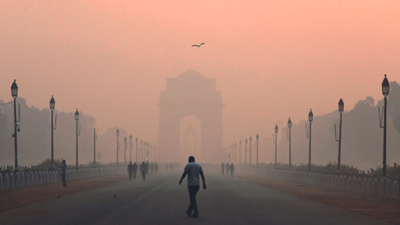Top Searches
- News
- City News
- delhi News
- Delhi pollution: As good as it gets? Air quality starts to drop, may worsen from mid-October
Delhi pollution: As good as it gets? Air quality starts to drop, may worsen from mid-October

The forecast of the India Meteorological Department (IMD) said calm winds, which affect the dispersion of pollutants, are likely on the evenings of Thursday and Friday.
NEW DELHI: After two consecutive 'good' air days, the Capital's air quality has started deteriorating slightly. Though the fire counts are low due to rain and cloud cover, System of Air Quality and Weather Forecasting and Research (SAFAR) said that stubble burning is likely to impact Delhi's air after mid-October.
Track the pollution level in your city
Experts have said it will take four days for the washout impact of widespread rain to disappear. Delhi's air quality index (AQI) on Tuesday was 66, which falls in the 'satisfactory' category, against Monday's 44, which is the 'good' category.

Data from the Indian Agricultural Research Institute (IARI), which follows the standard protocol 2021 notified by the Commission for Air Quality Management in National Capital Region and Adjoining Areas (CAQM), shows that the highest number of daily fires this season was reported on October 5 in Punjab with 130 cases.
The numbers drastically reduced to 19, three and four on October 8, 9 and 10, respectively. On Tuesday, Punjab witnessed a rise, as 45 paddy burning residue events were recorded. IARI data shows the cumulative stubble burning counts from September 15 to October 11 are 763 in Punjab, 83 in Haryana, 80 in UP and two in Delhi.
Gufran Beig, founder project director, SAFAR, said, "The impact of widespread rain on Delhi's air quality will disappear in four days and stagnant winter conditions will start prevailing in the region. The satellites are currently capturing low fire counts due to rain and cloud cover. However, as farm fires will now be visible, stubble burning would impact the city's air quality by mid-October, depending on the wind direction."
The forecast of the India Meteorological Department (IMD) said calm winds, which affect the dispersion of pollutants, are likely on the evenings of Thursday and Friday. The wind direction on Friday is likely to be north-westerly, which could favour the transportation of smoke.
Prof Vinay Sehgal, principal scientist and in-charge of Consortium for Research on Agroecosystem Monitoring and Modelling from Space (CREAMS) Laboratory at IARI, said, "Though daily paddy residue burning events are currently low, we are expecting a rise in activity. Since harvesting was delayed due to rain and if the respective state governments fail to control the fire, the farmers will start burning paddy. It will affect Delhi's air quality, depending on the wind direction."
Prof Sehgal added, "The data from previous seasons burning shows that peak season usually begins around October 26 when the daily fire count is the range of 4,000 to 6,000."
Track the pollution level in your city
Experts have said it will take four days for the washout impact of widespread rain to disappear. Delhi's air quality index (AQI) on Tuesday was 66, which falls in the 'satisfactory' category, against Monday's 44, which is the 'good' category.

Data from the Indian Agricultural Research Institute (IARI), which follows the standard protocol 2021 notified by the Commission for Air Quality Management in National Capital Region and Adjoining Areas (CAQM), shows that the highest number of daily fires this season was reported on October 5 in Punjab with 130 cases.
The numbers drastically reduced to 19, three and four on October 8, 9 and 10, respectively. On Tuesday, Punjab witnessed a rise, as 45 paddy burning residue events were recorded. IARI data shows the cumulative stubble burning counts from September 15 to October 11 are 763 in Punjab, 83 in Haryana, 80 in UP and two in Delhi.
Gufran Beig, founder project director, SAFAR, said, "The impact of widespread rain on Delhi's air quality will disappear in four days and stagnant winter conditions will start prevailing in the region. The satellites are currently capturing low fire counts due to rain and cloud cover. However, as farm fires will now be visible, stubble burning would impact the city's air quality by mid-October, depending on the wind direction."
The forecast of the India Meteorological Department (IMD) said calm winds, which affect the dispersion of pollutants, are likely on the evenings of Thursday and Friday. The wind direction on Friday is likely to be north-westerly, which could favour the transportation of smoke.
Prof Vinay Sehgal, principal scientist and in-charge of Consortium for Research on Agroecosystem Monitoring and Modelling from Space (CREAMS) Laboratory at IARI, said, "Though daily paddy residue burning events are currently low, we are expecting a rise in activity. Since harvesting was delayed due to rain and if the respective state governments fail to control the fire, the farmers will start burning paddy. It will affect Delhi's air quality, depending on the wind direction."
Prof Sehgal added, "The data from previous seasons burning shows that peak season usually begins around October 26 when the daily fire count is the range of 4,000 to 6,000."
FOLLOW US ON SOCIAL MEDIA
FacebookTwitterInstagramKOO APPYOUTUBE
Start a Conversation
end of article









